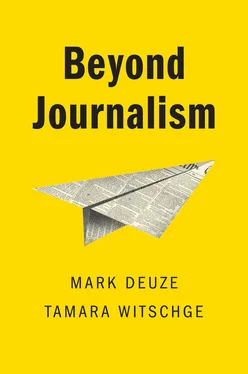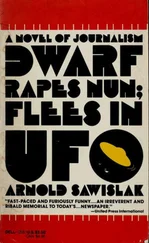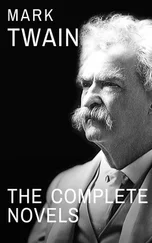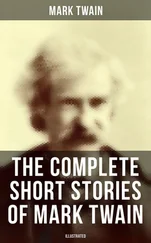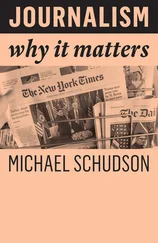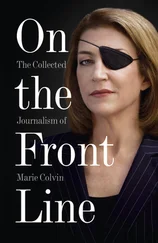During the next academic year, 2017–18, we used all the data from these thesis projects coupled with our own projects (such as Mark’s involvement with the international New Beats study, investigating what happens to journalists after they have been laid off) to conduct a comparative case study, and started the writing process for this book. At the same time, a new student cohort continued the work, shifting focus to an emerging trend of legacy news organizations who, noticing the energy and innovative potential of startup culture, create spaces within their companies for “intrapreneurial” teams of motivated reporters and editors – often supplemented with other professionals, including data analysts, social media experts, and representatives from marketing departments. Although the data from these studies could not be included in the formal analysis in our book, we want to acknowledge the work of the students involved, as their experiences and insights certainly contributed to our work. Livia Benders studied the Digital Storytelling Initiative (DSI) at the ABC in Australia, Wisanne van ‘t Zelfde looked at Dag6 (an online joint venture between a Dutch national newspaper and a public broadcaster), and Marit Willemsen observed the operations of the MediaLab, part of Dutch public broadcasting organization VPRO. The reporters and editors at both the MediaLab and the DSI found out they were being shut down during the time of our investigation, providing more testament to the precariousness of beyond journalism – within as much as outside of legacy institutions. At the time of writing, the work still continues, with independent journalism cases under investigation in Argentina (Revista Anfibia), Spain (El Diario), Cuba (PostData), and Belgium (Apache).
The project and this book can be considered to be a personal passion project for us. It is a way to operationalize our excitement about everything that is possible under the umbrella concept of “journalism” as much as it is a way to bypass or at least alleviate the frustration all too often found in journalism studies about the various problems legacy news organizations face. We wanted to focus on the people driving journalism forward, the professionals who are opening up the field while being committed to both personal motivation and professional and public ideals: making journalism content that matters, whether on a small scale informing individuals, or at societal level, responding to and affecting public issues.
Our aim throughout is to tell new stories that open our concept of what journalism is (or should be), and what journalism is for. To further our aim to tell the stories from the heart of the startup journalists, we have added in-depth contextual narratives, inserted as boxes in the empirical chapters. For this, we are deeply indebted to Andrea Wagemans, who has – as she has done for all the quotes used in this book – mined the data. We hope these boxes engage the reader, and add yet another way of letting the startups speak for themselves. We also acknowledge the invaluable work of Sofie Willemsen (as well as the anonymous reviewers of our initial manuscript), who provided expert comments and feedback on the manuscript. Through telling stories of startups we hope to do justice to the variety of actors; the multitude of forms, content, and audiences of those startups; and the scope of their excitement, drive, struggle, and ambition to make for what they feel is a better journalism.
1 Source: https://www.svdj.nl/dutch-journalism-fund. 2 For other publications related to the Beyond Journalism project we refer to our names in the reference section of this book. 3 NWO-funded project “Understanding public participation: Journalism and democracy in a digital age” (236-45-005), participants of the Journalism Elsewhere project include: Laura Ahva, Chris Anderson, Stefan Baack, Florence Le Cam, Irene Costera Meijer, Mark Deuze, David Domingo, Wiebke Loosen, Julius Reimer, Karin Wahl-Jorgensen, Victor Wiard, Andy Williams, run by Tamara Witschge. 4 “Entrepreneurship at Work: Analysing practice, labour, and creativity in journalism” (funded by NWO, project number: 276-45-003, 2015–20); “Exploring Journalism’s Limits: Enacting and theorising the boundaries of the journalistic field” (funded by NWO, project number: 314-99-205, 2017–19).
Introduction: What Is Journalism (Studies)?
What is journalism for? The starting point of this book is that journalism holds great potential to further the imagination, and performs a variety of functions (beyond informing citizens) that are necessary for society to thrive. We see, however, that in realigning itself to fit the changing social, technological, and political landscape, journalism as a profession, as well as news as an industry, struggles to transform itself. This is where journalism studies should come in, as a scholarly endeavor that assists and inspires the field to self-assess, move forward, and innovate. It is our contention that journalism studies – even before it became an established field at the dawn of the twenty-first century – furthered a rather narrow picture of the profession and its performance and role in society, thereby reifying its internal (industrial) operations, and limiting its creative potential.
Beyond journalism (studies)
In its eagerness both to prepare students for jobs in the news industry and to understand and explain journalism’s functioning in (the service of) democratic societies (while consistently framing this function as being under threat, thereby collapsing concerns about news as an industry with journalism as a profession), journalism studies and education have constructed a theoretical framework that considers the profession in terms of its more or less consensual news values, dominant frames, routinized operations, gatekeeping functions, and industrial arrangements. This is not to say scholars of journalism have not studied nonmainstream, oppositional, grassroots, or any other kind of nontraditional form of journalism in the past. Such “journalisms,” however, were generally reined in and tamed in theoretical frameworks emphasizing inside/outside binaries – for example, between mainstream and alternative journalism, between hard versus soft news, or between information and entertainment functions of the press. In doing so, a certain way of doing (and thinking about) journalism has prevailed – providing a benchmark of sorts.
At the same time, when journalism educators, students, and researchers talk about journalism, they cannot help but recognize the enormous diversity of the field. Professionals, amateurs, and hybrid variations of such identities, many institutions, many technologies, are all involved in the production of journalism across diverse channels and platforms. With so many actors involved of so many types, our conceptualizations of journalism as a single (more or less consensual) entity are challenged. When we revert to the same old dualisms, we risk explaining this complexity away, reflexively suggesting there is a core to the profession that continually reflects on itself vis-à-vis the developments in and challenges of the periphery , in a continuous circling of the wagons to keep truly original, edgy, pioneering, creative, nonformulaic, nontraditional ways of newsgathering, storytelling, and audience engagement at the perimeter. In keeping with this center/periphery distinction, anything not fitting preconceived notions of coherence is labeled as diverse, complex, or hybridized. Such approach does not acknowledge the messiness intrinsic to the object of study, a messiness amplified and accelerated by changes in working conditions, in information and communication technologies, and challenges to established business models: “we need to be ready to see the conceptual mess that we made through neatly fitting everything in categories that never quite fit” (Witschge et al. 2019: 657).
Читать дальше
